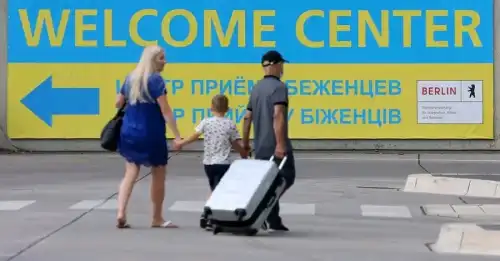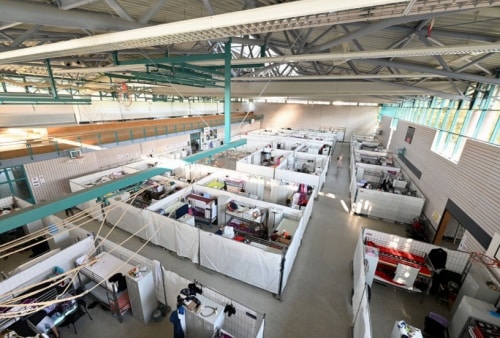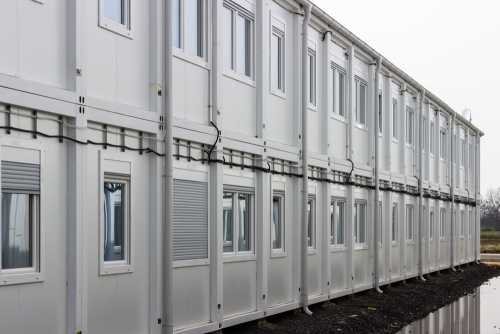“Photo: Vertical.com Since the beginning of Russia’s large-scale invasion of Ukraine in February 2022, Europe has organized the largest system of humanitarian support for Ukrainians since World War II. To provide shelter and security to our compatriots, Europeans began to equip gyms, offices and resorts as temporary accommodation. Briefly about – about refugee camps in Europe and how they are now […]”, — write: businessua.com.ua

Photo: Vertical.com
Since the beginning of Russia’s large-scale invasion of Ukraine in February 2022, Europe has organized the largest system of humanitarian support for Ukrainians since World War II. To provide shelter and security to our compatriots, Europeans began to equip gyms, offices and resorts as temporary accommodation. Briefly about – about refugee camps in Europe and how Ukrainians live there now.
Live as long as you need “Refugee camps” is a conventional name, which brings to mind Palestine and their famous refugee camps that have existed for almost half a century. In international documents – reception centers, temporary accommodation facilities, collective shelters or temporary reception centers.
They can be conditionally divided into four types:
- Border crossing points are the first places where refugees go through registration and receive food, assistance, and tickets.
- Transit centers are temporary places of stay for several days: gyms, train stations, converted warehouses.
- Collective centers – hotels, dormitories, office buildings, where you can live for weeks or months.
- Long-term centers are municipal and private facilities where accommodation is designed for months and years.
On average, Ukrainians can stay in the reception center from several days to three months. Then you need to move to municipal housing or find an apartment on your own. But in general, everything depends on the state: if in Germany three months is the deadline, then in Poland and the Czech Republic the terms of stay can be different, and in the Netherlands they can be extended almost indefinitely.

Initially, vacant premises were used for refugee reception centers, dividing them into sections. Photo: rubikon.com.ua
Poland as an example Poland became the first hub for millions of Ukrainians. At the border in Korchów, Ukrainian refugees were received in 2022 by the Hala Kijowska Młyny center – a former large warehouse converted into a reception point. People spent the night on folding beds, received hot meals and medical assistance. “Hala Kyivska” is a typical transit center: the stay lasted 1–3 days, then all refugees were transported on.
Several office buildings in Warsaw offered their space to shelter women and children. The offices turned into rooms where mostly Ukrainians lived, but there were also citizens of other countries who had a residence permit in Ukraine, for example, Syrians or Afghans.
This year, Poland reported that from November 1, most of the collective accommodation centers for Ukrainian refugees will work only for protected groups: pensioners, pregnant women, and people with disabilities. Others need to find housing and work or pay for their own accommodation and meals in this camp.
In the Masovian Voivodeship, about 3,000 people remain in refugee camps, and about 1,000 places are vacant. There are camps in Warsaw, Krakow, Poznan, Wrocław, Gdynia, and Gdańsk.
“We lived in the very center of Cologne” In three years, Germany sorted out the mess with refugees, moving them from tent cities at train stations and gyms to Landeserstaufnahmeeinrichtungen – official refugee reception centers. There are not enough of them, and the government constantly takes the initiative to build new ones, since not only Ukrainians but also refugees from other countries come to the country. And just as regularly, residents of the lands where these reception centers are located, protest against the construction – the Germans do not want too many enclaves in their country. But the problem remains: many federal states, such as Baden-Württemberg, redirect new refugees to other regions – there are no places.
Living conditions and rules in German refugee camps can be different: for example, in some centers you cannot stay with large pets.
After three months (maximum) of residence, people are allocated to municipal apartments, which resemble communal apartments.
– When we arrived in Germany, we got to the distribution center, from where we were immediately sent to the refugee camp, which was located in the very center of Cologne, – she said Briefly about Yuliya Savenka, a resident of Myrnograd in Donetsk region, who, together with her two children and her mother, was able to leave the city, which is constantly under fire. – We lived in the camp for about two weeks while the documents were being prepared. Then the distribution to different cities began – we got to the city of Heilenkirchen, and we were immediately given a 3-room apartment.
According to the interlocutor, the refugee camp was well equipped.
– Two-story houses like modular ones, toilet and shower are shared on the floor, but clean and tidy. There were 7 people in our room, all from Ukraine, we became friends. The children slept on bunk beds, we had a small kitchen. In general, I knew that people of different nationalities were settled in houses in refugee camps. I was a little worried that we would live next to those with whom we would not be able to get along. But there were, for example, no Syrians or Afghans in our house, only Ukrainians. So we were lucky. Our other acquaintances, who left Pokrovsk, lived in a tent camp in the field, says Yulia. – In Heilenkirchen, we live in an apartment that is located in the same block with two others – families with children also live there.
Another of our interlocutors recalls that she came to the refugee camp in Mlyny in Poland, and they were set up in a gym, divided into small residential blocks.
– We lived next to Iraqis who left Ukraine and had a residence permit with us. The gym constantly smelled of old rubber and soup, which was fed to us by visiting volunteers or employees of this center. We were there for almost a month and all the time we were busy with something: processing documents, someone needs to translate, explain how to get where. Children ran together, became friends, without knowing the language they communicated without problems – I don’t know how. Then we received documents and were able to rent housing – we had a “financial cushion” that I hid on myself and did not take off all this month, – shared Kateryna Klimchuk from Dnipro.

Even today, most refugees will have to spend up to three months in camps. Photo: rubikon.com.ua
“A camp is a camp” Another refugee from Ukraine, who called himself Yevgeny, told that slightly different conditions awaited him in the German refugee camp. He does not name the city, but the camp is located in the same state of Baden-Württemberg, which is no longer able to accept refugees due to a lack of places.
– We lived in real containers, there was not much furniture – a bed and a bedside table per person. There are three of us – me, my wife and a child. We were lucky – no foreigners were moved to us, but in other “containers” there was a mixture of races and nationalities. I did not hear about conflicts, but the tension was felt, because everyone perceived the arrangements differently. Someone dragged some carpets into the house, someone didn’t like it – but the matter did not go beyond the dispute, – says Yevhen. – A camp is a camp. We checked in several times a day, constantly filled out some questionnaires in order to go outside the camp – we had to take a pass. We stayed there for a month, then distant relatives finally came to us and took us home. Before that, we filled out a hundred forms again. It turns out that we, as refugees, could not come to our relatives right away – only through the camp stage. Now we rent a small apartment, the child went to kindergarten, we work.
In other countries that provide temporary protection to Ukrainians, the system of reception and distribution of refugees is built in approximately the same way. There is no longer the mess of 2022 – there is a clear understanding of who came, for what and for how much. The extension of temporary protection until 2027 (in most EU countries) does not mean that all Ukrainians will continue to live in camps or municipal housing on state assistance. So, it is quite possible that temporary living in camps will become a thing of the past, and becoming a refugee will be more difficult.
Source: kp.ua
Please wait…
